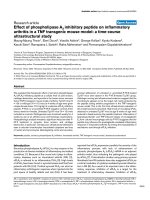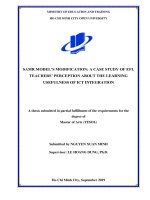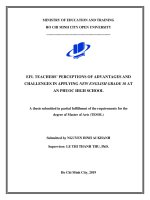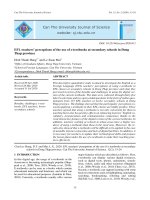Efl teachers perceptions of the impact of the jolly phonics program on childrens pronunciation in a kindergaten
Bạn đang xem bản rút gọn của tài liệu. Xem và tải ngay bản đầy đủ của tài liệu tại đây (1.1 MB, 101 trang )
MINISTRY OF EDUCATION AND TRAINING
QUY NHON UNIVERSITY
TRAN THI KIEM
EFL TEACHERS’ PERCEPTIONS OF THE IMPACT OF THE
JOLLY PHONICS PROGRAM ON CHILDREN’S
PRONUNCIATION IN A KINDERGARTEN
Field: Theory and Methodology of English Language Teaching
Code: 8140111
Supervisor: Bui Thi Dao, Ph. D
BINH DINH - 2023
BỘ GIÁO DỤC VÀ ĐÀO TẠO
TRƯỜNG ĐẠI HỌC QUY NHƠN
TRẦN THỊ KIỂM
NHẬN THỨC CỦA GIÁO VIÊN TIẾNG ANH VỀ TÁC
ĐỘNG CỦA JOLLY PHONICS ĐẾN PHÁT ÂM CỦA TRẺ
MẪU GIÁO
Ngành: Lý luận và phương pháp giảng dạy Tiếng Anh
Mã số: 8140111
Người hướng dẫn: TS. BÙI THỊ ĐÀO
BÌNH ĐỊNH - 2023
i
STATEMENT OF AUTHORSHIP
I hereby certify that the research work presented in this report "EFL
Teachers’ perceptions of the Impact of the Jolly Phonics Program on
Children’s Pronunciation in a Kindergarten" has been conducted under the
supervision of Bui Thi Dao, PhD, a lecturer at Quy Nhon University.
I have not utilized any sources other than those cited in the references.
Furthermore, I affirm that this thesis has not been submitted to any other
institution to obtain a degree.
Binh Dinh 2023
Tran Thi Kiem
ii
ACKNOWLEDGEMENTS
First of all, I am grateful to my thesis supervisor, Bui Thi Dao, PhD, for
her amazing supervision. As an MA student at Quy Nhon University, I was
impressed by her knowledge and professional skills in teaching-related
matters. She also helped me expand my horizons in the field. She was
extremely patient with me and helped me overcome challenges as I worked on
my thesis, and I appreciate that. I consider myself fortunate to have her help
me with my work. I also take this opportunity to express gratitude to all the
lecturers who took part in the training process of the M.A course at Quy Nhon
University for their scholarly knowledge and experience as well as their
inspiration which incited me to widen my research from various perspectives.
Next, I would like to extend my heartfelt gratitude to all the lecturers in
my M.A course for their unwavering dedication and enthusiasm in teaching
throughout the past two years.
Special thanks go to the head as well as the staff of Eco-school for their
assistance and encouragement for me to conduct the study at the facility.
Last, but not least, I am grateful for all the support and encouragement I
received from my beloved family throughout the process of writing this thesis
in particular and my life in general.
Binh Dinh 2023
iii
ABSTRACT
This study investigates issues relating to the impact of Jolly Phonics on
kindergarten children's pronunciation in a preschool in Quy Nhon City. The
purpose of this qualitative evaluation study was to investigate teachers’
perceptions of Jolly Phonics implemented to improve kindergarten children's
pronunciation. The research questions focused on EFL teachers’ perceptions
of the program's impact on children’s pronunciation and the strategies used in
Jolly Phonics. The data for the study was collected through tests, interviews,
and classroom observations, and then analyzed both quantitative and
qualitative approaches. The findings of the study revealed (1) the impact of
Jolly Phonics on children's pronunciation and (2) EFL teachers’ perceptions
of the impact of and strategies used in Jolly Phonics. Positive perceptions
aligned with the implementation of practices targeting the effectiveness of the
program, which is in favor of curriculum planning and professional
development to improve kindergarten children's pronunciation.
iv
TABLE OF CONTENTS
STATEMENT OF AUTHORSHIP ................................................................ i
ACKNOWLEDGEMENTS............................................................................ ii
ABSTRACT ....................................................................................................iii
ABBREVIATIONS ....................................................................................... vii
LIST OF TABLES .......................................................................................viii
LIST OF FIGURES ....................................................................................... ix
CHAPTER 1: INTRODUCTION.................................................................. 1
1.1. Rationale ............................................................................................. 1
1.2. Aim and Objectives of the Study ...................................................... 2
1.2.1. Aim of the Study............................................................................... 2
1.2.2. Objectives of the Study..................................................................... 3
1.3. Research Questions ............................................................................ 3
1.4. Scope of the Study .............................................................................. 3
1.5. Significance of the Study ................................................................... 3
1.6. Organization of the Study ................................................................. 4
CHAPTER 2: LITERATURE REVIEW...................................................... 6
2.1. Pronunciation and Its Factors and Techniques in Learning and
Teaching ..................................................................................................... 6
2.1.1. Pronunciation .................................................................................. 6
2.1.2. Factors Influencing Learning Pronunciation................................ 7
2.1.3. Pronunciation Teaching Techniques.............................................. 9
2.2. Concept of Phonics........................................................................... 13
v
2.2.1. Synthetic Phonics Explicit ............................................................. 14
2.2.2. Multisensory Phonics Instruction ................................................. 16
2.3. Jolly Phonics ..................................................................................... 17
2.3.1. Definition of Jolly Phonics ............................................................ 17
2.3.2. Five Skills of Jolly Phonics ........................................................... 19
......................................................................................................................... 23
2.4. Teachers’ Perceptions...................................................................... 25
2.4.1. Definition of Teachers’ Perceptions ............................................. 25
2.4.2. Types of Perception........................................................................ 26
2.5. Children's Development and Language Development ................. 27
2.6. Previous Studies ............................................................................... 29
CHAPTER 3: METHODOLOGY............................................................... 32
3.1. Research Design ............................................................................... 32
3.2. Research Setting and Participants ................................................. 33
3.2.1. Research Setting............................................................................. 33
3.2.2. Participants..................................................................................... 33
3.3. Data Collection Instruments ........................................................... 34
3.3.1. Pre-test and Post-test...................................................................... 35
3.3.2. Interview ......................................................................................... 36
3.3.3. Observation..................................................................................... 37
3.4. Data Analysis .................................................................................... 38
3.5. Research Procedures........................................................................ 39
3.6. Reliability and Validity.................................................................... 40
vi
3.7. Summary ........................................................................................... 40
CHAPTER 4: FINDINGS AND DISCUSSION ......................................... 41
4.1. Impacts of Jolly Phonics on Kindergarten Children's
Pronunciation .......................................................................................... 41
4.1.1. Tests ................................................................................................ 41
4.1.2. Observation..................................................................................... 49
4.2. EFL Teacher’s Perceptions of Impacts of Jolly Phonics on
Kindergarten Children’s Pronunciation .............................................. 55
CHAPTER 5: CONCLUSIONS AND RECOMMENDATIONS............. 60
5.1. Conclusion......................................................................................... 60
5.2. Limitations ........................................................................................ 61
5.3. Implications ...................................................................................... 61
5.4. Suggestions for Further Research .................................................. 63
REFERENCES .............................................................................................. 65
APPENDICES ............................................................................................... 13
vii
ABBREVIATIONS
ELT English Language Teaching
EFL English as a Foreign Language
ELLs English Language Learners
CEFR Common European Framework for Languages
K Kid
L1 First Language
L2 Second Language
MSL Multisensory Structured Language
YLs Young Learners
viii
LIST OF TABLES
Table 1 Language Acquisition..................................................................................28
Table 2 Study Population .........................................................................................34
Table 3 Research Questions and Instruments...........................................................35
Table 4 Scales used in Tests.....................................................................................41
Table 5 Pre-experimental Test Results.....................................................................42
Table 6 Pre-test scores..............................................................................................43
Table 7 Post-experimental Test Results ...................................................................44
Table 8 Post-test Score and Performance.................................................................45
Table 9 Average Results between Pre-test and Post-test Results.............................47
Table 10 Pre-test and Post-test Scores .....................................................................48
ix
LIST OF FIGURES
Figure 2. 1 Sequencing of Sounds According to Jolly Phonics ..................... 21
Figure 2. 2 Phonics Action and Song............................................................. 22
Figure 2. 3 Identifying Letter Sounds and Blending...................................... 23
Figure 2. 4 Student’s Progress ....................................................................... 24
Figure 2. 5 Tricky Words Tree....................................................................... 24
1
CHAPTER 1: INTRODUCTION
This chapter introduces the background information on the issue
discussed in this study. Additionally, it is established with the framework of
the thesis, which consists of the rationale, aim and objectives, research
questions, scope, significance and organization of the study.
1.1. Rationale
In the globalization era, it cannot be denied that English is very
important. Harmer (2001) stated that English offers many great opportunities
to anyone who has sufficient English language knowledge. Pinter (2006)
stated that most parents agree that the sooner young learners (YLS) learn a
second language, the better they will be in language learning.
Pronunciation is “the way a word or a language is spoken or the
manner in which someone utters a word.” If one is said to have “correct
pronunciation”, then it refers to both within a particular dialect or simply the
way a particular individual speaks a word or language.”, according to
Wikipedia.
In the fascinating language acquisition journey, children embark upon a
remarkable exploration of sounds, words, and expressions that eventually
shape their ability to communicate effectively.
Pronunciation isn't merely a technical aspect of language; it holds
profound significance in a child's development, influencing their
communication skills, cognitive growth, social interactions, and even self-
confidence. Teaching children about pronunciation early on for all many
reasons. If children can pronounce words correctly, they will communicate
effectively and even lay the foundation for future reading and writing skills
later on. By the time children reach the ages of 3-5, they have some
challenges to identify letters and sounds different from their mother tongue.
2
This makes a difficult age for working on pronunciation, so teachers should
try to teach them in a suitable way.
In Vietnam, the challenges children face with the pronunciation of
learning English are both common and nuanced. These challenges can be
attributed to linguistic differences between Vietnamese and English, as well
as the complex sound system inherent in the English language. As a result,
these pronunciation difficulties warrant attention and specialized support to
ensure effective language acquisition and communication skills among
Vietnamese children. To address these challenges, tailored strategies are
necessary. Patient and skilled educators can employ techniques such as
phonetic exercises, speech therapy, and audio resources to help children
develop more accurate pronunciation. Incorporating interactive activities,
role-playing, and phonemic awareness exercises into the curriculum can
create an engaging learning environment that focuses on improving
pronunciation skills.
Despite the increasing amount of research on the Jolly Phonics program
on teaching English to children. However, there is a lack of research
addressing teachers' perceptions of the impact of the Jolly Phonics program
on children’s pronunciation in kindergarten. Therefore, the writer has been
motivated to select the topic "EFL teachers’ perceptions of the impact of the
Jolly Phonics program on children’s pronunciation in a kindergarten". This
study is expected to be able to provide insightful analysis and instructional
recommendations that will help to enhance kindergarten children’s
pronunciation and lead to more successful learning outcomes.
1.2. Aim and Objectives of the Study
1.2.1. Aim of the Study
This study aims to explore EFL teachers' perceptions of the impact of the
3
Jolly Phonics Program on kindergarten children's pronunciation.
1.2.2. Objectives of the Study
The objectives of the study are:
- To investigate the impact of Jolly Phonics on kindergarten children’s
pronunciation
- To find out EFL teachers’ perceptions of the impact of the Jolly
Phonics Program on kindergarten children’s pronunciation
1.3. Research Questions
To achieve the aim and objectives of the study, the researcher focuses
on the following research questions:
- What is the impact of the Jolly Phonics program on kindergarten
children’s pronunciation?
- What are EFL teachers’ perceptions of the impact of Jolly Phonics on
kindergarten children’s pronunciation?
1.4. Scope of the Study
This research study focuses on investigating the impact of Jolly Phonics on
kindergarten children’s pronunciation and EFL teachers’ perceptions of the
impact of Jolly Phonics on kindergarten children’s pronunciation. Thus, the
study is limited to four skills in Phonics Pupil Book 1, consisting of learning
letter sounds, letter formation, blending, and identifying sounds in words
which mainly affect kindergarten children's pronunciation.
1.5. Significance of the Study
This study is undertaken to provide valuable insights into EFL teachers'
perceptions of the impact of Jolly Phonics on kindergarten children. It is
anticipated that the study's conclusions will help educators better comprehend
difficulties or barriers they face when instructing YLs in pronunciation. This
4
study is important from an educational perspective, both theoretically and
practically.
Theoretically, the study contributes to the teaching theories of EFL
teachers to sharpen their pronunciation teaching skills and the study may be
used as a source of reference for further research.
Practically, the findings of this study may benefit EFL teachers,
children, and researchers. As for EFL teachers, the findings of the study could
raise their awareness of how they perceive the use of Jolly Phonics in class.
As a consequence, they will endeavor to implement it effectively so that
children can improve their pronunciation. This study can also be used as a
reference, not only by kindergarten EFL teachers but also by EFL teachers at
other school levels who want to employ the program to serve their teaching.
For children, this study hopes to help them know and be aware of the phonetic
system. Finally, as for researchers, those who share the same interest in this
topic could certainly rely on this research to find reliable and useful
references for their related studies.
1.6. Organization of the Study
The study is presented in five chapters: Introduction, Literature Review and
Theoretical Background, Methodology, Findings and Discussion and Conclusion.
Chapter 1, Introduction, consists of the rationale, aim, and objectives of
the study, research questions, scope of the study, significance, and an
overview of the study’s organization.
Chapter 2, Literature Review, presents pronunciation and its factors and
techniques in learning and teaching, phonics and its types, introduction to the
Jolly Phonics program, teachers’ perceptions, children's development and
language development, phonological awareness, and related studies related to
the topic of this study.
5
Chapter 3, Methodology, covers the research methods, data collection,
and data analysis.
Chapter 4, Findings and Discussion, presents the results gained in the
processing of the data and discusses the results of the data analysis.
Chapter 5, Conclusion, summarizes the findings, presents the
limitations of the study of Jolly Phonics, gives implications and provides
some suggestions for further study.
6
CHAPTER 2: LITERATURE REVIEW
Chapter 2 is to shape the theoretical framework of the study. It reviews
the literature knowledge related to (1) Pronunciation and its
factors and techniques in learning and teaching, (2) Phonics and its types (3)
introduction to Jolly Phonics (4) Teachers’ perceptions (5) Children
development and language development and (6) Related studies on using
Jolly Phonics to teach children
2.1. Pronunciation and Its Factors and Techniques in Learning and
Teaching
2.1.1. Pronunciation
It is said that children absorb language as a sponge. They do not learn
only vocabulary and grammar but also pronunciation. But they can acquire
correct pronunciation only when the model itself (the teacher) pronounces
English well. There are more ways to learn good pronunciation, e.g. listening
activities and talking to native speakers. But they are less common and less
available for children than their teacher whom they are listening to the whole
classes long to.
Dunn (1983) believed that young children have an enviable ability to
pick up sounds and patterns of language. Unlike most adolescents and adults,
they do not need to be taught pronunciation. “If the model speaker’s
pronunciation is good or they have access to recordings, and the children have
opportunities to use language in real situations, they are capable of refining
their pronunciation until in some cases it is hardly distinguishable from the
model”. Mistakes in pronunciation made by children are usually in the stress,
rhythm or intonation of single word, phrase or sentence rather than in
individual sounds or clusters of sounds.
7
An idea introduced by Lojová (2005) says that adults learn faster than
children. Lojová stated that, “This can be noticed in the field of grammar and
lexis, but on the other hand, children learn as quickly as adults or even
quicker in the field of phonetics”.
Teaching English pronunciation is an area of language teaching that
many English teachers avoid. While there are many textbooks and instruction
manuals available, as well as books on the theories and methodologies of
language teaching there is comparatively little on learning pronunciation.
Certainly, we need to teach pronunciation. There is a big difference
between a ship and a sheep and a pear and a bear! When teaching any
language as a foreign or second language, our first goal for our students is
basic communication, and that can't happen if no one can understand what
they are saying.
2.1.2. Factors Influencing Learning Pronunciation
Králová (2016) claims that comparing and contrasting two language
systems is insufficient to adequately capture the scope of proficiency in a
foreign language, including pronunciation. The extra-lingual environment and
a person's interactions with language systems (phonic interference) determine
how well they can pronounce words (Sabol, 1993). Additional factors that
affect language learning include the kind of language contact (direct,
mediated, intermittent, permanent), the type of contact (natural, artificial), the
type of bilingualism (individual, group), and the type of bilingualism (learned
both languages as a child, learned both languages as an adult, one being
suppressed).
The following variables on pronunciation in a foreign language are
listed by Gilakjani (2011). Foreign language pronunciation is influenced by
one's native accent. The effect of the national accent becomes more
pronounced as the learner ages. More than faults in a single sound,
8
intelligibility is affected by stress, intonation, and rhythm. The development
of pronunciation in learners is also determined by exposure and ambition to
acquire a foreign language. The desire for native-like pronunciation might
stem from either personal or professional reasons for learning English. When
it comes to demanding accurate pronunciation, some students are better than
others. Pronunciation Attitude Inventory measured how well students
pronounce words in the target language. Pupils who focus more on
pronouncing words correctly in their target language typically improve their
pronunciation. The achievement of foreign language competency and
pronunciation is influenced by several factors, including motivation, good
attitudes, exposure to the target language, and receptivity to the target culture.
According to Pennington (1994) pronunciation is viewed as a
component of linguistics rather than conversational fluency. Pronunciation is
taught last in conversational classes because teachers consider it to be the
least useful language skill. As a result, they prioritize teaching other
language-related topics over teaching pronunciation (Elliot, 1995). The
effectiveness of explicit training in aiding foreign pronunciation acquisition is
a matter of debate. It has been discovered that phonetic education can
significantly enhance the allophonic articulation of adult English language
learners.
According to Lenneberg (1967), age has a significant determining
effect when it comes to the pronunciation of foreign languages. It is strongly
related to the Critical Period Hypothesis idea, which claims that infants can
acquire a foreign language between the ages of 2 and 13 and become as
proficient as native speakers, particularly in pronunciation (Loewen &
Reiders, 2011). This idea shows that older language learners hardly ever
attain native-like speech and fluency.
9
Králová (2010) claims that starting at age six, children's capacity to
distinguish between sounds from foreign languages that are similar to their
native tongue is diminishing.
The foreign language picks up the mother tongue's sound patterns,
according to Avery and Ehrlich (1992). The learners may be unable to
pronounce sounds if they are not included in the native sound inventory. The
rules for combining sounds in one's native tongue and the target language
may differ. It is possible to transfer native language stress, rhythm, and
intonation patterns to the target language. Since language rules differ from
one language to the next, learners may encounter difficulties due to all of
these issues.
2.1.3. Pronunciation Teaching Techniques
The Common European Framework for Languages (2001) recommends
teaching pronunciation right from the beginning of foreign language learning.
According to the CEFR, pronunciation should be developed via contact with
authentic spoken language. The recommended techniques are listening and
repeating, drilling, minimal pair drills, ear training, phonetic training, reading
aloud, imitation, tongue twisters, sound-color charts, phonics, songs/rhymes,
recording learners’ pronunciation, etc. Also clapping, clicking, tapping,
gestures, mirrors, visual aids, etc. can be used for teaching pronunciation. It is
advised to combine different teaching techniques.
The most popular and common pronunciation teaching techniques
recommended with a focus on age suitability are analyzed below.
2.1.3.1. Listening and Repeating
Listening and repeating is probably considered one of the oldest
pronunciation teaching techniques (Jones, 1997). In this technique, a teacher
or recorded native speaker is set as a model for imitating sounds. It is one of
the most traditional ways of teaching pronunciation, but it can be made more









